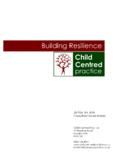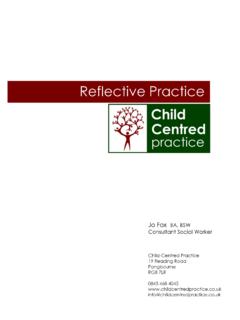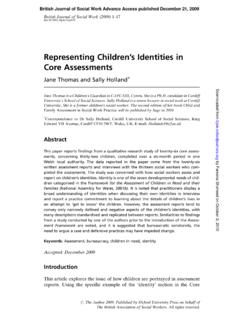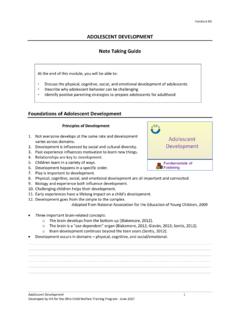Transcription of Handout 8: Assessing Parents’ Capacity to Change
1 Handout 8: Assessing parents Capacity to Change Date Updated: 18/10/07 Document Ref: This Handout is based on Assessment of Parental motivation to Change by Jan Horwath & Tony Morrison in: Jan Horwath (ed) (2001): The Child s World. London: Jessica Kingsley. Give up MAINTENANCE Sustaining/internalising new behaviour ACTION Rehearsing new thinking, behaviours, relationships or DETERMINATION Informed decision to Change LAPSE or RELAPSE Return to some/all old behaviours. Give up or start again CONTEMPLATIONW eighing up the pros/cons. Start of Change process Exit Decide not: Exit PRE-CONTEMPLATION Defensive/denial/projecting blame/depressed/unaware of the problem The assessment framework guides professionals to assess the child s developmental needs, as well as the parent s Capacity to meet these needs.
2 If an assessment suggests that a child s health and development are impaired or likely to be impaired, the assessment needs to identify the changes needed, both in terms of parenting and support services. If the Change needed is Change in the parenting, then this should lead to an assessment of the parents Capacity to Change . This is in order to assess their willingness to work to achieve and sustain the changes required of them. Change must be assessed over time. Handout 8: Assessing parents Capacity to Change Date Updated: 18/10/07 Document Ref: Capacity to Change is made up of motivation and ability, and the authors suggest that if either of these is missing, the parent in question will lack the ability to Change .
3 They suggest that the use of DiClemente s model of Change (1991) (above) might be helpful. Assessments often focus on information gathering but often fail to consider and understand motivation and Change and to engage parents in that process. This model can be used with parents , especially when their engagement with professionals is involuntary. The basic premises are: a. Change is a matter of balance. If the motivational forces are greater than the status quo forces, Change will be likely to happen. b. For the process to work, professionals need to assess and work with parents in terms of their readiness to accept or deny the need for Change . The blocks to Change in terms of the model above are pre-contemplation and relapse.
4 1 The assessment of each of the stages Pre-contemplation Most families are at this stage at the start of contact with the agencies. They may have a vague notion of wanting Change , but not that they need to Change . parents at this stage are unable to make a full psychological commitment, as they have not yet come to terms with the need to Change . The implications for this is are that early contracts need to be reviewed as (if) the parents move into the Change cycle. Contemplation At this stage, the parents consider that there is a problem, and can explore how to tackle it. Effective intervention will depend on whether external motivation can be transformed into internal motivation.
5 This means that workers need to be able to combine external sanctions with engagement with parents in order to effect Change . parents may need time to: Look at themselves and come to terms with what they see Appreciate the child s needs Count the cost of Change Handout 8: Assessing parents Capacity to Change Date Updated: 18/10/07 Document Ref: Identify the benefit of Change Identify goals which are meaningful to them The professional task is to assess sources of motivation and: Recognise the parents ambivalence, compliance, genuine commitment and Capacity to Change Recognise that each parent may be at a different stage of the Change process That different changes may be required from each parent Assess the motivational/status quo sources in the extended family The authors identify 7 stages of contemplation as follows: a.
6 Accept that there is a problem b. Accept some responsibility for the problem c. Have some discomfort about the problem d. Believe things must Change e. See yourself as part of the problem f. Make a choice to Change g. See the next steps towards Change Determination At this stage, parents should be able to express: Real problems and their effect on the child Changes they wish/should make Specific goals to achieve How parents and professionals will co-operate to achieve the goals The rewards of meeting the goals Consequences if Change is not achieved Professionals need to be clear about agreed plans, and plans should be detailed and specific. Plans should be for incremental Change , as motivation to Change is more likely if there is early support and clear expectations.
7 Handout 8: Assessing parents Capacity to Change Date Updated: 18/10/07 Document Ref: Action This is the point of Change , where parents use themselves and services. There can be a danger of confusion and parents feeling overwhelmed (and consequently disengaging) at this stage, so clarity of aims and objectives is essential. Any agreement which was made at the pre-contemplation stage needs to be reviewed to see if it is still valid. Maintenance This stage is about consolidating changes made, rehearsal and testing of new skills and coping strategies over time and in different conditions. Professionals need to pay attention to relapse prevention, essentially work to anticipating stresses and triggers which might arise.
8 This can be the stage where one parent is able to Change , and the other not thus causing stress in the relationship. If this is due to professionals concentrating their efforts on one parent, this sets up failure, so including both parents is important. The assessment task is to ascertain if parents are able to internalise changes if external motivators are relaxed. Lapse and Relapse Change is cyclical, and most of us do not succeed first time. Change comes from repeated efforts, re-evaluation, renewal of commitments and incremental successes ( ). A lapse can usually be dealt with, but a relapse, such as a return of the abusive behaviour is not so easy to deal with.
9 Overall, the task for professionals is to increase the weight of the factors which promote Change , whilst decreasing the forces for the status quo. Motivation is interactional, so look to the wider network (partners/professionals /family/friends and community) for sources of motivation, stresses and weaknesses. Handout 8: Assessing parents Capacity to Change Date Updated: 18/10/07 Document Ref: Managing ambivalence Ambivalence is an ordinary response to Change , so the assessment of parent s real commitment. The response to Change model is useful. It identifies four possible types of response to Change , depending on effort and commitment to Change : Dissent and/or avoidance Tokenism Genuine commitment Compliance EFFORT HIGH LOW HIGH Genuine commitment Tokenism COMMITMENT TO Change LOW Compliance Imitation Approval seeking Dissent Avoidance The professional task is to be aware of ambivalence, and assess how parents manage ambivalence.
10 Main messages Assess both parents . Be child centred, especially on the timing of Change , can children wait? Being forced to engage heightens parents sense of failure and uncertainty. If parents are unsure, they are likely to respond negatively.





